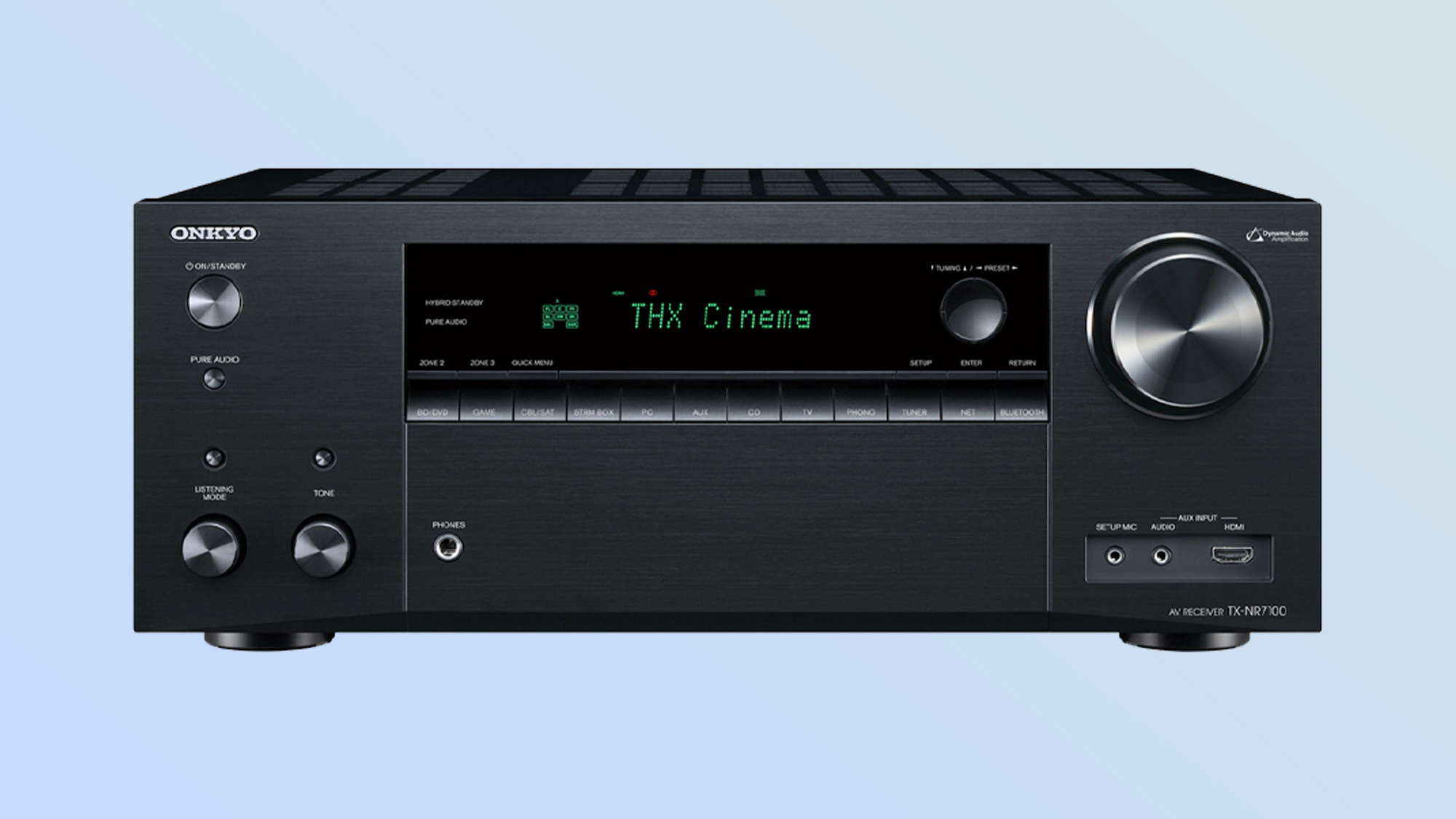
Price: $1,299 / £999 / AU$2,299
Colors: Black
Ports: HDMI, Digital Optical Audio, Digital coaxial audio, analogue stereo, Component, Ethernet, USB
Audio channels: 9 (7.1.2)
Audio formats: Dolby Atmos, Dolby Digital, DTS:X, DTS, PCM
Power output: 9x 100W
Wireless: Wi-Fi, Bluetooth, Apple Airplay, Chromecast
Smart assistant: Alexa, Google Assistant
Dimensions: 17.1 x 14.92 x 6.81 inches (w/d/h)
Weight: 22.9 pounds
Onkyo may have been off the AV receiver scene for a few years, but has returned with a swagger. The Onkyo TX-NR7100 is a 9-channel home theater receiver with copious power, and an advanced feature specification to entice both gamers and movie fans.
The TX-NR7100 has strong connectivity, which makes it a go-to model for hooking up ultra hi-res, or fast frame rate sources — all 6 HDMI inputs offer 8K and 4K 120Hz playback support. It boasts 100W per channel amplification and can be configured for up to 7.1.2 or 5.1.4 Dolby Atmos loudspeakers. There's also DTS:X compatibility, plus IMAX Enhanced certification and THX post processing. Interested? You should be.
For this review, I listened to the UK and European amplifier version. Read on to see how it performed and to discover if it makes the grade to rank as one of the best AV receivers around.
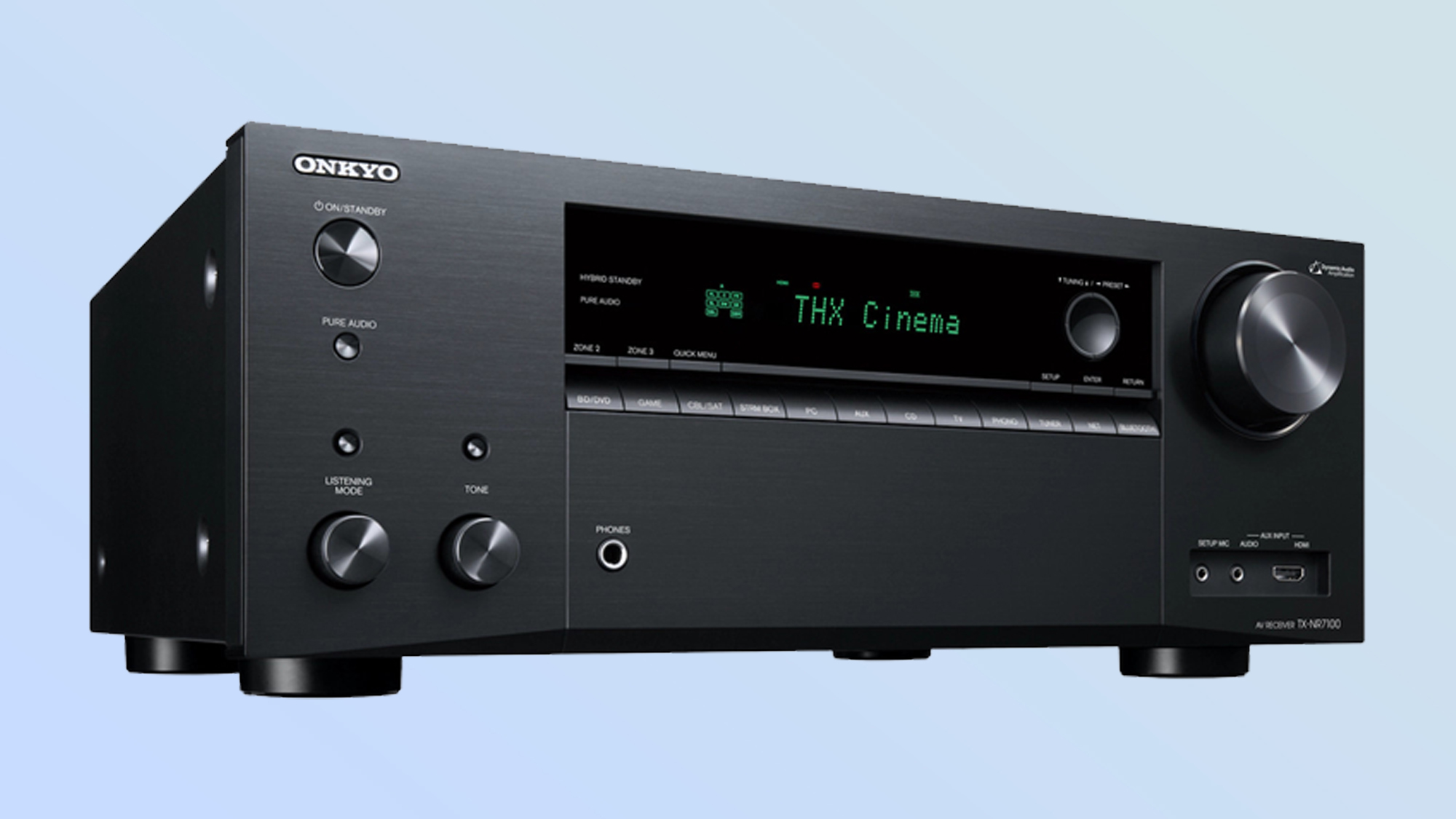
Onkyo TX-NR7100 review: Price & Availability
Available now, the Onkyo TX-NR7100 sells for$1,299. In Australia, it’s priced at AU$2,299, while in the UK, the Onkyo TX-NR7100 retails for £999. It comes in a black finish only and is available to buy direct from the Onkyo online store.
It can regularly be found discounted and is currently on sale for $699 at Crutchfield and Amazon.
Onkyo TX-NR7100 review: Design
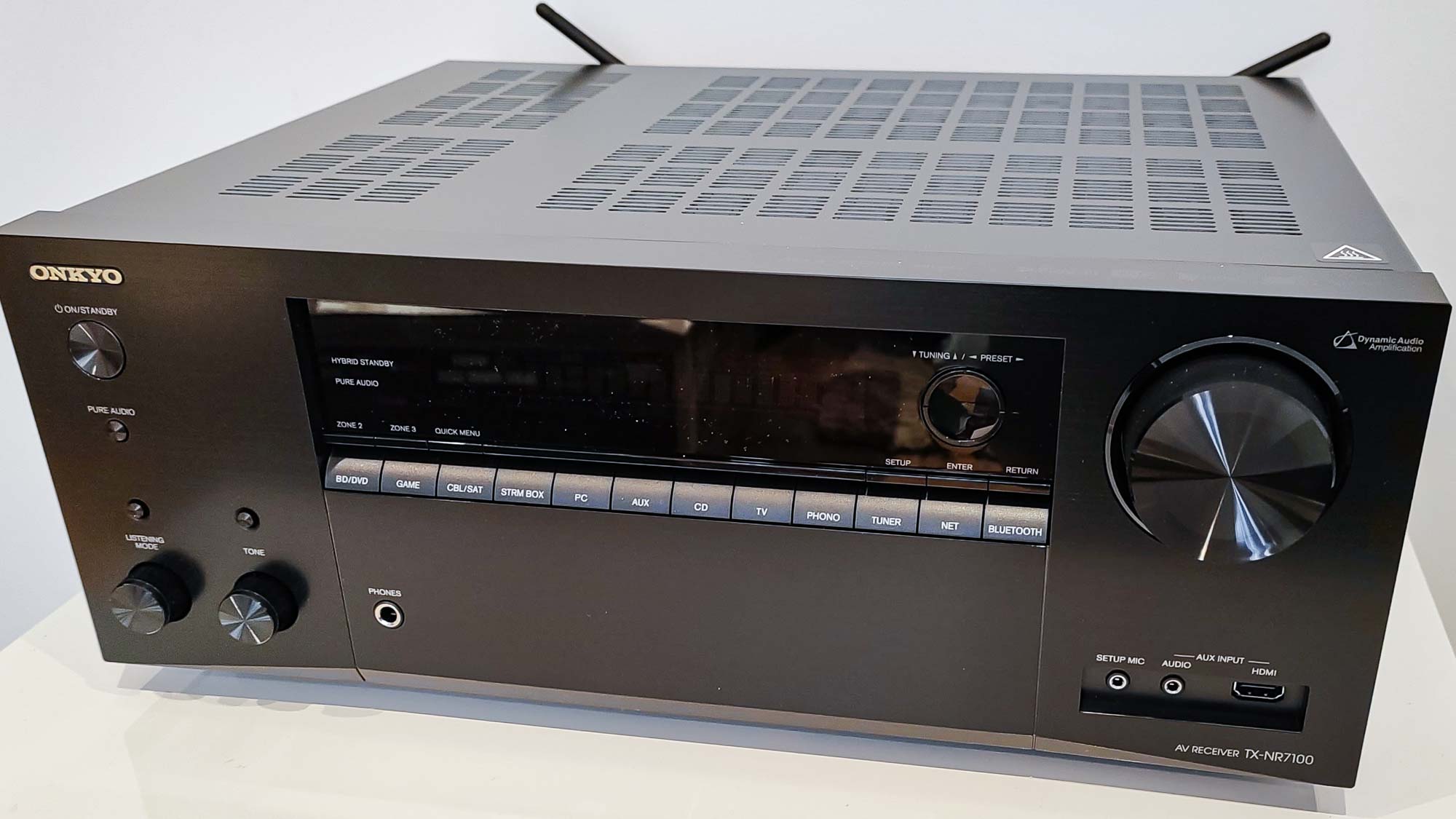
The TX-NR7100 AV receiver has the same angular lines and distinctive large green display as its predecessors, but it comes with a cutting-edge specification.
The overall design is clean and utilitarian. There’s no pull down panel on this model, just a large volume dial to the right, and a bar of function buttons beneath the main display. Helpfully though, there are front panel connections including an HDMI port alongside an audio mini-jack and headphone jack. It’s a relatively light receiver weighing in at 10.4kg.
The biggest break with tradition is the supplied compact remote control. It feels a bit of a budget design and doesn’t offer any backlighting of keys, which means you could be fumbling in the dark when trying to access functionality come movie night.
Onkyo TX-NR7100 review: Connectivity
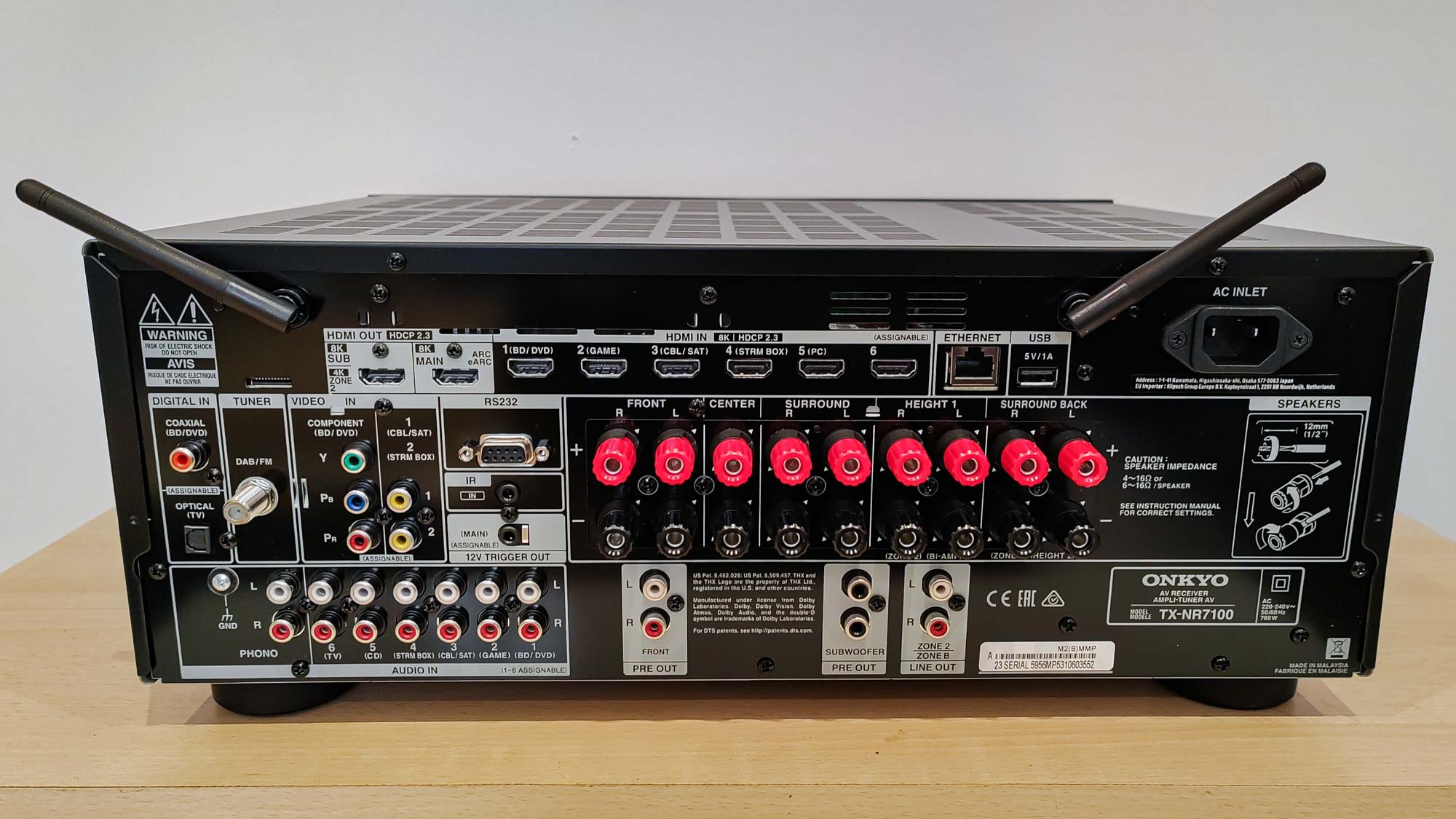
Connectivity is generous though, and will be key to its appeal. All 6 rear HDMI inputs, plus the two HDMI outputs (main and second zone) are HDMI 2.1 4K 120Hz 8K enabled, so you’re unlikely to run out of space in the foreseeable when it comes to hooking up ultra hi-res, or fast frame rate sources. The main monitor output is eARC enabled.
The HDMI board is also compliant with VRR (Variable Refresh Rate), ALLM (Auto Low Latency Mode) and QFT (Quick Frame Transport), acronyms that will doubtless make every gamer’s heart beat a little faster.
Other inputs include coaxial and digital optical audio, 6 analog stereo pairs, one component input (attractive to owners of legacy games consoles?), an MM phono stage input for a turntable, USB, and Ethernet, to support bi-directional Bluetooth aptX and Wi-Fi. A pair of screw-on Wi-Fi/Bluetooth aerials are joined by an FM/AM/DAB radio aerial.
There’s also a stereo pre-out, and a second zone stereo option, alongside two subwoofer outputs.
Onkyo TX-NR7100 review: Setting up

Installation is aided by a step-by-step onscreen guide. It’s similar to what we’ve seen on the Denon AVR-X4800H and Marantz Cineam 50 AV receivers, albeit without the polish.
There are two options when it comes to Room EQ: Onkyo’s own AccuEQ system, and Dirac Live room correction.
Both are used in conjunction with the supplied setup mic. The former is handled by the AVR itself. You can collect data from up to nine listening positions which is then processed. To test the unit with AccuEQ I took 6 measurements to cover off my listening position(s).
Dirac Live Room Correction is carried out on the Onkyo Controller app, and for this I used three positions.
There are noticeable differences between the two room calibration systems. AccuEQ does a decent job and delivers quite profound bass slam. Dirac Live produces a more cohesive immersive soundstage, with really sublime panning around and up high, but I found it lighter on bass. Even so it was my preferred option.
Onkyo TX-NR7100 review: Features
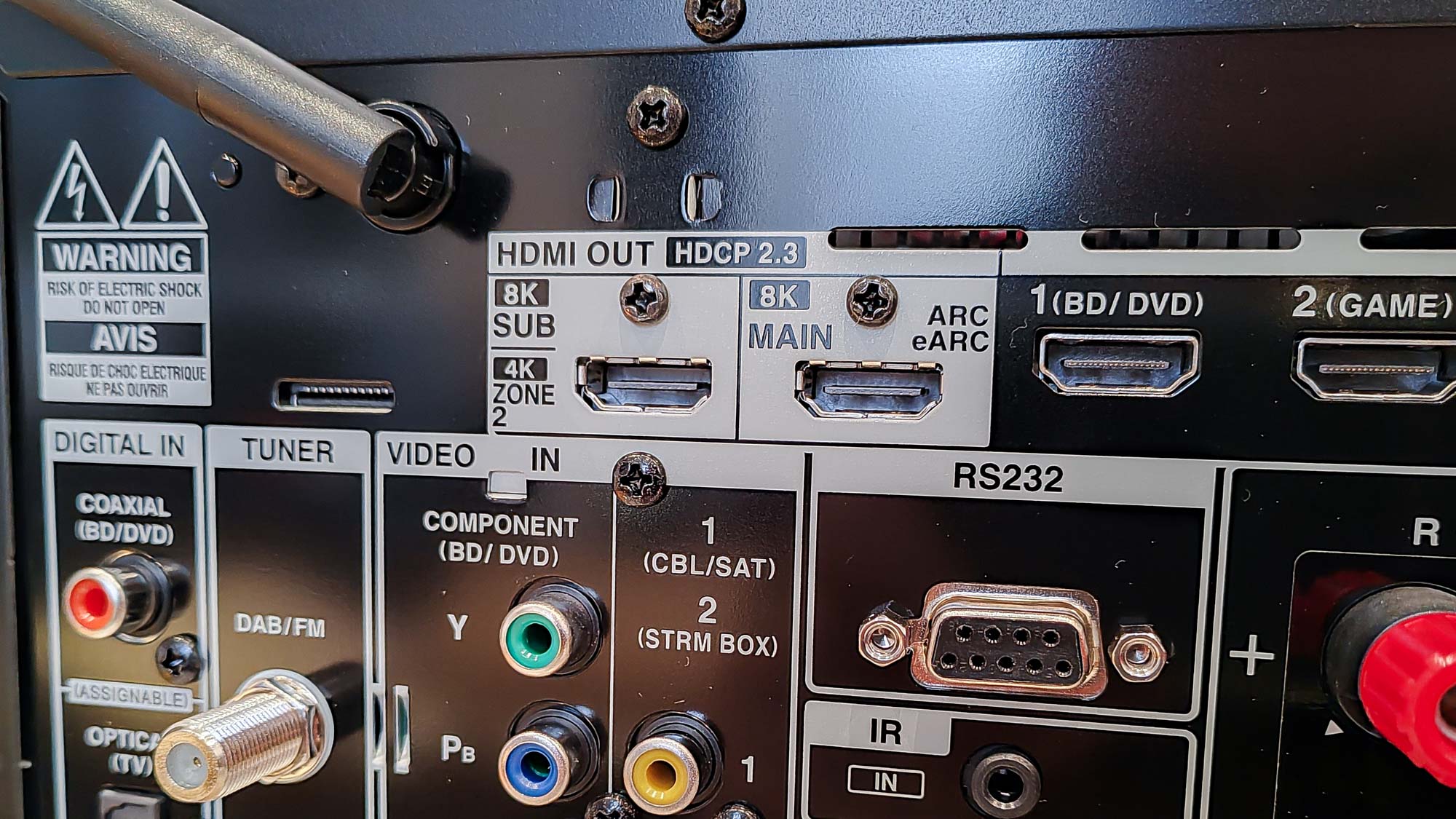
Featuring 9 channels of amplification, the NR7100 can be configured for up to 7.1.2 or 5.1.4 Dolby Atmos loudspeakers. For this audition it was run in a standard 5.1.2 pattern.
Power output is rated at 100W (into 8 ohms) per channel, but there’s some dynamic head room on top of that. Suffice to say it goes loud, and would suit moderately sized movie rooms.
Codec support covers Dolby Atmos and DTS:X, and comes with IMAX Enhanced certification and THX post processing.
Somewhat unusual is a specific Klipsch optimization mode, designed to be used with speakers from the stablemate loudspeaker brand, specifically the crossover values that apply to Klipsch’s Reference Premiere speakers. Onkyo parent Premium Audio Company, also owns Pioneer and Jamo, so it’s quite a family!
There’s smart home support for Amazon Alexa, Google Assistant and Apple AirPlay. The Onkyo is also DTS Play-Fi enabled, so it can be used as part of a larger Play-Fi ecosystem, both for multiroom audio as well as hi-res music streaming.
This Onkyo will even work with a Sonos Home Sound System, when paired with a Sonos Port. This means you can use the Sonos-app to control input selection and volume control.
Onkyo TX-NR7100 review: Performance

THX is a feature that has fallen from favour when it comes to home theater, thanks to the advent of object based sound formats, but it still has value when it comes to upmixing. It brought a huge improvement in staging and storytelling to sci-fi based TV dramas as the THX processing adds scale and extra ambience to onscreen drama.
The AVR also handles complex sound sequences well. When Napoleon Solo makes his escape from East Germany, in Guy Ritchie’s The Man from U.N.C.L.E, the ring of the steel zipline is satisfyingly metallic, before Solo travels from stage left to right, all while a funky 1960s inflected soundtrack is clearly delineated in the mix.
With power output rated at 100W per channel, and some dynamic head room on top of that, this AV receiver goes loud and will suit moderately sized movie rooms.
It can also sound ominous and heavy. Spinning the Blu-ray of Everest in Dolby Atmos, the deep rumble of the ice storm rolls across the left of the soundfield, before howling winds lash the entire soundstage. The thunderous LFE (Low Frequency Effects) is deep and chilling, and when the ice shards race in, you can almost feel their sting.
Taken as a two channel stereo amplifier, the TX-NR7100 rather under performs its price point. It sounds fine, with plenty of toppy detail and mid-range character, but it doesn’t quite deliver the emotional richness I was hoping for. Audio fidelity runs to DSD256, and PCM audio to 192kHz/24-bit, but compared to similarly priced AVRs, I found its two-channel audio a little one dimensional.
Things improve when all channels are invited to fly. Dolby Atmos Music benefits from precise panning, and there’s an energy and excitement about the soundstage that’s deliciously infectious.
Onkyo TX-NR7100 review: Verdict
There’s plenty to recommend the TX-NR7100. If you’re a gamer, or an early adopter of 8K, then the AVR’s provision of universal HDMI v2.1 support is hugely reassuring.
I was enamoured by the option of THX processing, if only because it appeals to my sense of home theater legacy. While Dolby Atmos is fast becoming standard with new streaming shows, there’s still plenty of content to view, or on disc, that’s passive multichannel, and benefits from THX post processing.
Having Dirac Live on tap via the app is a significant bonus, and when it comes to value, features and overall performance, the TX-NR1000 delivers.







